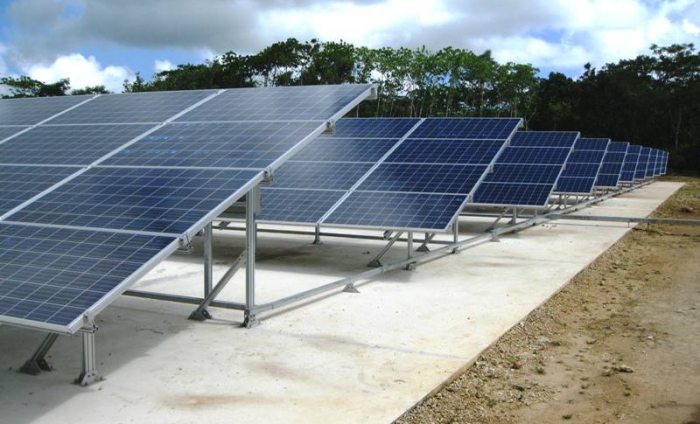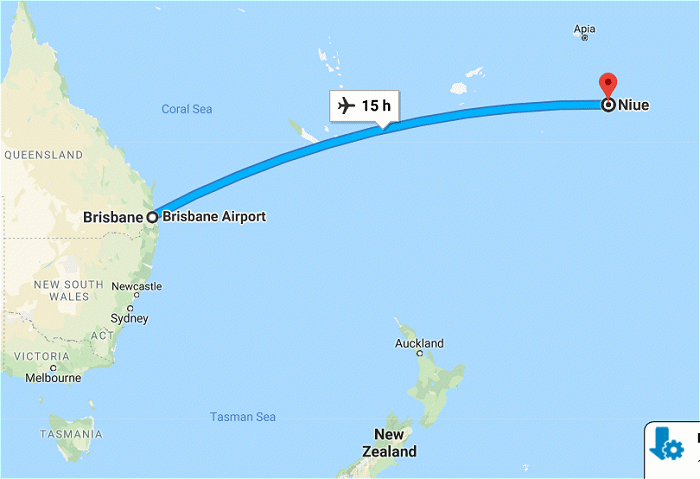
Image: Niue Power Corporation solar array | Source: Pacific Islands Forum Secretariat
New Zealand Prime Minister Jacinda Ardern isn’t only popular at home (and here in Australia, particularly with a certain 60 Minutes reporter) – she’s just won a bunch of new fans in Niue with the promise of more solar power.
In case you haven’t heard of it, Niue is small island nation in the South Pacific Ocean, 2,400 kilometres northeast of New Zealand and around 3,800 kilometres east of Brisbane.

Image: Google Maps
Covering 260 square kilometres, Niue has a permanent population of around 1,600 people, but welcomes around four times that number of visitors a year. It’s one of the smallest countries in the world, with residents living on top of one of the largest raised coral atolls on the planet.
But the “paradise like no other” could be in trouble. Like other Pacific island nations, Niue is threatened by rising sea levels connected to climate change. The ocean is also becoming more acidic, making it more difficult for corals to build their exoskeletons. This has ramifications across the local marine food chain and for Niue’s fishing industry. Extreme rainfall and heat events are also becoming more common.
While only a bit player, Niue has been a contributor to electricity related greenhouse gas emissions as it was fully dependent on imported fossil fuels for power generation until relatively recently. According to the International Renewable Energy Agency (IRENA), more than 800,000 litres of diesel was guzzled by Niue’s four 508 kW Caterpillar C18 generators in 2010. This diesel-generated electricity is also very expensive.
Solar Energy (And Foreign Aid) To The Rescue
Solar power has been helping Niue wean itself off fossil fuels. Back in 2013, just 52kW was in place. The following year, a 200 kW solar power system (pictured above) along with battery storage was installed with cash from the Pacific Environment Community (PEC) Fund.
In 2015, the nation’s government set a renewable energy target of 80% by 2025, with solar energy to continue play a major role. However, to reach this target Niue was going to need more financial and technical help.
New Zealand, Niue’s main source of foreign aid (which is the country’s principal source of income), has been stepping up to the plate in this regard. Previous funding for solar panels and energy storage will bring Niue’s renewable generation from 13 per cent last year to 40 percent this year – and more is on the way.
“We will provide a further $5 million to support the development of solar energy generation in Niue. This builds on the $5 million we have already provided and will help Niue meet its renewable energy target of 80 per cent by 2025,” announced New Zealand Prime Minister, Jacinda Ardern yesterday. “Achieving this target will create annual savings of close to $1 million for the Government of Niue, which can be applied to other development priorities such as health, education and other public services.”
Aside from being downright neighbourly (even if that neighbour is thousands of kilometres away), it’s a wise financial move for New Zealand. Not only will it help wean Niue off diesel, it will also reduce Niue’s reliance on the Kiwis for cash – assistance that was already being phased out.
As for New Zealand itself, it’s also to ramp up its own renewables street cred. We reported in October last year that as a result of a deal with the Green Party, Labour will set a target of 100% renewable electricity by 2035. The country doesn’t have that far to go – nearly 85% of electricity generation in New Zealand came from renewable sources in 2016.

 RSS - Posts
RSS - Posts



Very slow aeroplane thought would take a tad over 4 hours, fly to US in that time
Interesting how the map appears to show that Auckland is in a country separate to New Zealand, with New Zealand apparently comprising of only the South Island.
It is a bit like putting the name Australia on that little island below Victoria -Tazminnia, I think it is named.
Also interesting is, above Niue, the country named Apia (which is actually part of Western Samoa, which is kind of related to NZ, unlike Eastern Samoa, which was apparently partitioned by the USA, kind of like the USSR partitioning the pat of Poland that the germans did not want).
It will be interesting to find whether, in the next hundred yeards, any state of Australia can catch up with where NZ is now, in terms of the proportion of velectricity generation that comes from clean energy – “nearly 85% of electricity generation in New Zealand came from renewable sources in 2016”.